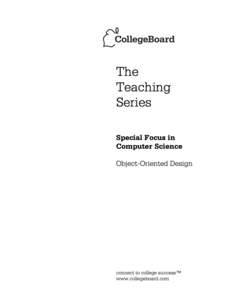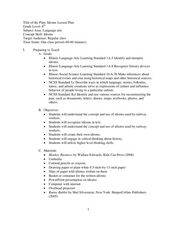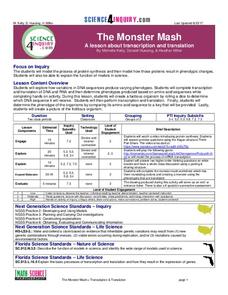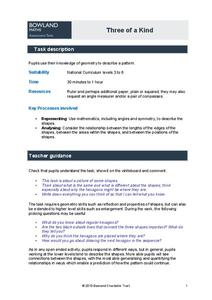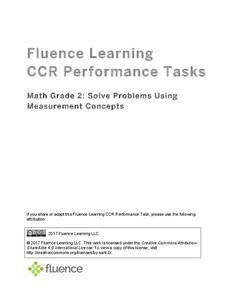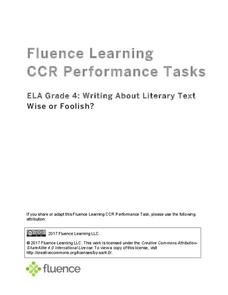Reading Through History
The Leadership of George Washington
Why did Americans choose George Washington as their first president? After reading the resource, pupils discover why citizens trusted him to lead the country. They learn about his time as a military leader, as well as his actions after...
College Board
Object-Oriented Design
Just jump in with both feet. To better teach Java, one must think Java. The College Board built document immerses teachers in object-oriented design by providing several resources for use. Resources include teaching strategies, design...
Curated OER
Think Fast
Pupils practice brainstorming. They discuss how brainstorming can increase their ability to "think on their feet," and assist them in preparing for the pressure of a timed test.
Curated OER
Idioms Lesson Plan
Sixth graders discover idioms. In this idioms lesson, 6th graders evaluate idioms and discover their meaning. Students read Runny Babbit by Shel Silverstein and create unique idioms. Assessment rubric is provided.
Curated OER
Houghton Mifflin Social Studies/Chapter 13, Lesson 1 The Past Shapes the Future (pp. 292-295)
Fourth graders reflect upon the events of the past in order to make cognitive connections to present or future history. Students use Blooms Taxonomy to attain higher levels of thinking.
Curated OER
Animal Farm
An exploration of "Animal Farm" can be a way to get students thinking about politics, history, and literature.
Sargent Art
Picasso and Beyond!
After reviewing the life and art of Pablo Picasso, learners set out to create abstract, cubist, relief portraits. They'll draw, color, paint, and cut out portraits just like the ones Picasso created. The lesson is extremely well written...
Happy Moose Apps
Bitsboard - Education, Games, and Flashcards for Learning Reading, Spelling, and more
Learn everything from sight words to French vocabulary with this versatile study app. While the material that comes pre-loaded on the app is mostly based on learning how to read and spell, the app has the potential to be useful for any...
Science 4 Inquiry
The Monster Mash
Young scientists create monsters by applying their knowledge of transcription and translation. They randomly find the DNA, assign it a codon, and build monsters piece by piece.
Curated OER
Language of Poetry
Students demonstrate a higher level of thinking in writing a poem that delivers a message of wisdom and is metaphorical in meaning. They study the use of metaphors in poetry as well as the meaning and use of concrete and abstract words...
Curated OER
Taoism
Students identify and interpret Taoism. Students gain knowledge of various eastern philosophies. Students transfer knowledge gained using the higher order thinking skills for analysis. Students identify the key figure in Taoism....
Curated OER
Compass Rose Tossing
Young scholars use different pieces of equipment to practice throwing and catching. They use the cardinal directions of North, South, East and West in making a compass rose with the equipment. They must use higher order and decision...
Curated OER
Logic Plus Math Equals Critical Thinking
Logic problems can be an integral part of the school day.
Curated OER
Technology Lesson Plan
Students measure various objects using non-standard units. The goal is for them to practice measuring in order to apply the physical act to various objects found in the classroom. The lesson is ideal for the kinesthetic learners and...
Curated OER
South Korea
Students use primary and secondary resources in order to investigate the culture of South Korea. They use guiding questions that progressively lead them to higher order thinking to make connections from the information to how people live.
Curated OER
EARLY COLORADO ADVERTISING
Students investigate the history of advertising in Colorado.They analyze newspapers and advertisements putting them into different categories. Students question the content to develop higher order thinking skills.
Bowland
Three of a Kind
One is chance, two is a coincidence, three's a pattern. Scholars must determine similarities and differences of a regular hexagon undergoing dilation. They look at lengths, angles, areas, and symmetry.
Howard Hughes Medical Institute
Building Ecological Pyramids
Looking for a fresh take on traditional food/energy pyramids? Conduct an innovative activity where pupils build their own! The lesson uses research data from Gorongosa National Park in Mozambique for a real-life safari touch. Scholars...
Curated OER
Print & Go ESL
Improve reading comprehension with a set of ESL worksheets. Kids read through various passages, note which facts are true or false, mark their opinion on two statements, and write a short reply based on a writing prompt.
For the Teachers
Story Strips Sequencing
What happens next? Work on story sequence with a lesson that prompts kids to put a story back in order. Additionally, they discuss what would happen if one event was missing from the sequence.
Fluence Learning
Writing an Opinion: Is Pride Good or Bad?
Does pride really goeth before the fall, or can it be essential to one's development? Second graders read two of Aesop's fables that refer to pride in their morals, and write a short essay about whether pride is good or bad, based on...
Fluence Learning
Solve Problems Using Measurement Concepts
Young mathematicians demonstrate what they know about measurement with a four-task assessment that focuses on estimation, length, and inches.
Fluence Learning
Writing About Literary Text: Wise or Foolish?
A three-part assessment promotes reading comprehension skills. Class members read literary texts and take notes to discuss their findings, answer comprehension questions, write summaries, and complete charts.
National Library of Medicine
Your Environment, Your Health: Food Safety
Did youknow that chicken causes the greatest risk of food-borne illness. The fourth unit in a six-part series addresses food safety. Scholars research common scenarios of food causing illness through the National Institute for Health....



